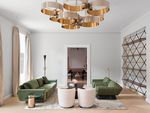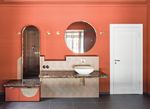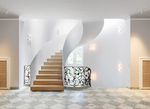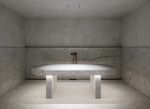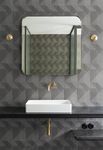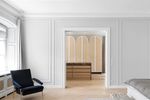Past lives - Arnold / Werner
←
→
Page content transcription
If your browser does not render page correctly, please read the page content below
past lives The rich history of a century-old villa in Munich informs but doesn’t overwhelm its renovation by Arnold/Werner Architekten text: joseph giovannini photography: boo yeah 116 INTERIORDESIGN HOMES SPRING.21 SPRING.21 INTERIORDESIGN HOMES 117
Every century-old house has a
past, but the landmarked 1929
Villa Bogenhausen in Munich
has layers of history—personal,
architectural, social—all of
which factored into the recent
makeover of its interiors by
Arnold/Werner Architekten.
Designed by prominent local
architect Robert Seitz in a sim-
plified château style transi-
tioning into Modernism, the
16,000-square-foot, four-level
residence was confiscated from
its Jewish owners in 1933 and
only restituted to the family
after World War II. In the early
1950s, however, they sold the
stately house for use as a for-
eign consulate. By the time the
villa’s current occupants—a
family of five—acquired the
property recently, it was in need of major work.
The building’s original architectural elements, from its bones to its
finishes, were worn but intact. The kitchen was water damaged and
outdated. The floor plan was mostly unaltered, with grand public
spaces on a ceremonial ground floor, including an impressive entrance
gallery and a living room, dining room, and smoking parlor that form
a handsome enfilade opening onto a wide terrace. The oak parquet
and marble floors were finely crafted but showing serious signs of
age, as were the paneling and moldings. The house’s signature feature,
a spiral marble staircase—lightened by a delicate wrought-iron railing
of winding tendrils—was in particular need of TLC.
The owner engaged two firms—Hilmer Sattler Architekten and
Schindhelm Architekten—to restore and stabilize the building’s shell
and systems and to earn permits from the city’s preservation agency.
Arnold/Werner was brought on board to tackle the interior that,
Previous spread: The richly pigmented
custom paint on the ceiling, walls, and
molding, and Britt Moran and Emiliano
Salci’s glossy lacquered-metal console
table turn the smoking parlor into a warm
and inviting haven.
Top: A built-in banquette enlivens a skylit
hallway on the children’s floor, which
was formerly undeveloped attic space.
Center: It is reached by a new extension
to the original spiral staircase. Bottom:
Contemporary furniture in the living room
includes Thierry Lemaire’s massive sofa
and armchairs, a pair of Yabu Pushelberg
club chairs, and Pietro Russo bookshelves.
Opposite: A custom ceiling fixture floats
above the dining room’s Gio Ponti table
and vintage Augusto Savini chairs.
118 INTERIORDESIGN HOMES SPRING.21 SPRING.21 INTERIORDESIGN HOMES 119depending on the specific space involved, required restoration, remod-
eling, expansion, or precision acupuncture in the form of new built-
ins, contemporary fixtures, and fresh colors.
The Arnold/Werner team, led by interior architects Ulrike Buhl and
Tim Honkomp, proceeded as if they had two clients—the family and
the house itself—both of whom they “interviewed” in depth. Done in
collaboration with the two other firms, the interrogation of the villa
comprised painstaking study and documentation of the building so
that any interventions would understand, respect, and renew its his-
toric fabric. Interviewing the family, including the children, involved
a series of formal and informal meetings aimed at ensuring that the
recast interior fit exactly their expectations and living patterns.
The family conversations established that the house needed to oper-
ate equally well at an intimate scale, with before-school breakfasts in
a homey kitchen, for example, and at a larger social scale, since the
parents regularly hold receptions for up to 50 people. While the family
wanted the more public, less casual areas to be “welcoming,” Honkomp
reports, they asked that the private quarters on the upper floors be
“more relaxed—and calm.”
On the ground level, the checkerboard marble floor in the entrance
gallery and the herringbone oak parquet in the three large rooms
were restored, and their walls painted distinctive custom hues: pale-
gray and white for the gallery and living room; salmon pink for the
doors, window frames, and dado paneling in the dining room; and
watermelon red for the walls and ceiling in the smoking parlor. “We
needed colors that would read at night in candlelight and dim illumi-
nation,” Honkomp notes. The designers used custom light fixtures
throughout, including striking chandeliers composed of overlapping
brass rings in the gallery and living room. “We wanted what we
added to be contemporary,” Buhl says.
Furniture selections were made by another firm, Robert Stephan
Interiors, which mixed midcentury Italian pieces like the dining
room’s sleek Gio Ponti table from 1959 surrounded by Augusto Savini
curved-back chairs from 1960s with more recent designs such as Britt
Moran and Emiliano Salci’s glossy lacquered-metal console table in
the smoking parlor. Contemporary items include the living room’s
massive sofa and armchairs by Thierry Lemaire, which flank a pair of
compact club chairs by Yabu Pushelberg.
“It speaks to the rich ambiguity of the
original architecture that this serene but
sumptuous Turkish bath looks and feels part
of the villa’s essence”
This page: Brass accents in the form of door frames and faucets bring a soft glow to the
monochromatic hammam in the basement. Opposite, from top: Spotlighting adds a note
of drama to the circular shower room. The custom massage table is constructed from
solid blocks of Carrara marble, the same material that clads the walls.
120 INTERIORDESIGN HOMES SPRING.21 SPRING.21 INTERIORDESIGN HOMES 121Clockwise, from top: In the husband’s bathroom, Patricia Urquiola’s subtle geometric-
pattern tiles background a custom mirror above Konstantin Grcic’s crisp rectangular sink.
While most of the kitchen’s walls are clad in oiled white-oak paneling, smoked-oak slats
at one end of the long room conceal appliances, a professional chef’s galley, and a
mudroom. Brass-frame mirrors, floating marble counters, and deep-pigment wall paint—
all custom—create an abstract composition in the wife’s bathroom. A built-in wall of
wardrobes and a custom marble-top chest of drawers outfit the wife’s dressing room off
the main bedroom, which is furnished with a Gio Ponti armchair.
PROJECT TEAM SASCHA ARNOLD, STEFFEN WERNER, FLEUR KAMENISCH: ARNOLD/WERNER
ARCHITEKTEN. HILMER SATTLER ARCHITEKTEN, SCHINDHELM ARCHITEKTEN: ARCHITECTS OF
RECORD. ROBERT STEPHAN INTERIORS: FURNITURE CONSULTANT. PSLAB: LIGHTING CONSULTANT.
NORBERT WANGEN: KITCHEN CONSULTANT. STEININGER STEINMETZ: STONEWORK. PRALLER &
WERNER: WOODWORK.
PRODUCT SOURCES
FROM FRONT DIMOREMILANO: CONSOLE TABLE (SMOKING PARLOR); ATELIER ARETI: SCONCES
(STAIRCASE, HALLWAY). UPHOLSTERY FABRIC: KVADRAT (HALLWAY). THIERRY LEMAIRE: SOFA,
ARMCHAIRS (LIVING ROOM). MAN OF PARTS: CLUB CHAIRS. PIETRO RUSSO: BOOKSHELVES.
MOLTENI&C: TABLE (DINING ROOM). HÄSTENS: BED (BEDROOM). ANTONIO LUPI DESIGN: BASIN
(WIFE’S BATHROOM). LAUFEN: BASIN (HUSBAND’S BATHROOM). MUTINA: WALL TILE (BOTH
BATHROOMS). THROUGHOUT PSLAB: CEILING FIXTURES. VOLA DENMARK: FAUCETS. TOPSTYLE
FLOORING: OAK HERRINGBONE. KT.COLOR: PAINT.
The original kitchen, though
Modernist in its time—designed
in what Honkomp describes as
“Mallet-Stevens style”—was
conceived for a large staff, so it
had to be gutted and reconfig-
ured, much to the distress of
the team. “We nearly cried,”
Honkomp admits. The remade
facility includes an adjacent
mudroom for transitioning af-
ter sports; a large granite-top
island incorporating an infor-
mal dining counter where par-
ents can help kids with home-
work; and, tucked behind an
end wall of dark oak slats that
also conceals the refrigerator
and other appliances, a profes-
sional galley kitchen where a
chef prepares most meals.
Working surfaces and under-
counter cabinets are stainless
steel, while the walls are pan-
eled in oiled white oak, “to
warm the room for a cozier
feeling,” Buhl says.
On the second floor, the
original layout for the main
suite and two guest bedrooms
was retained. The large bath-
rooms were simply updated
with sleek modern fixtures set
on custom marble counters,
each ensemble an abstract
composition. An elegant extension to the spiral stairs gives access to
the previously undeveloped attic space, which now houses the chil-
dren’s bedrooms, a couple of which boast mezzanine sleeping lofts.
The basement also underwent a major transformation, including
the creation of an authentic hammam—an expansive sequence of cool,
warm, and hot rooms, all of them clad in Carrara marble and furnished
with custom tubs, basins, and massage tables carved from the same
material. It speaks to the rich architectural ambiguity established by
the original house—and to the aesthetic judgement of the current de-
sign team—that this serene but sumptuous Turkish bath looks and
feels part of the villa’s DNA.
122 INTERIORDESIGN HOMES SPRING.21 SPRING.21 INTERIORDESIGN HOMES 123You can also read




